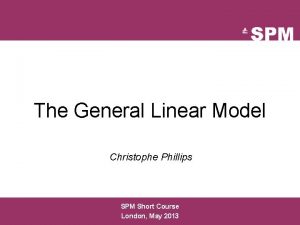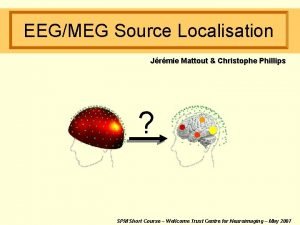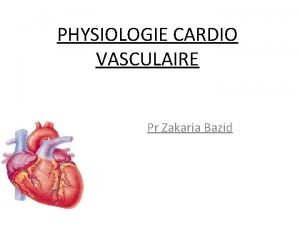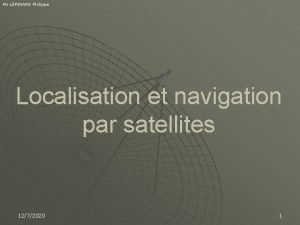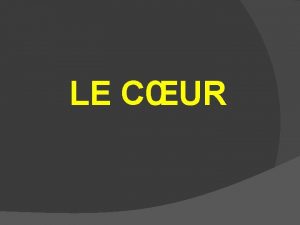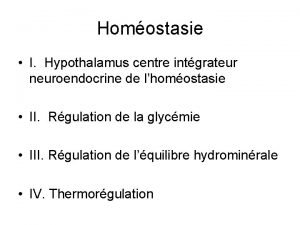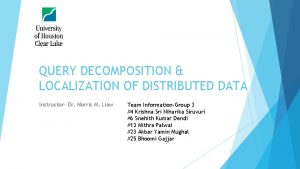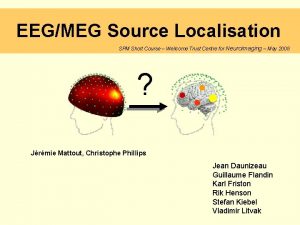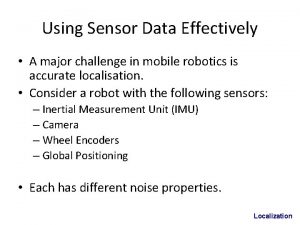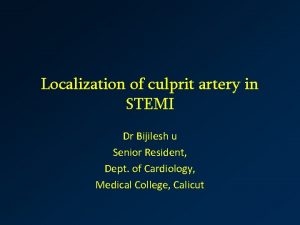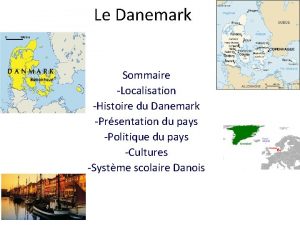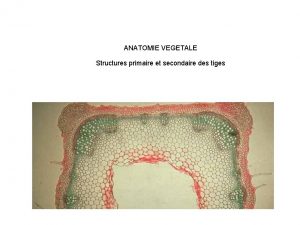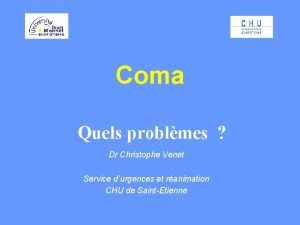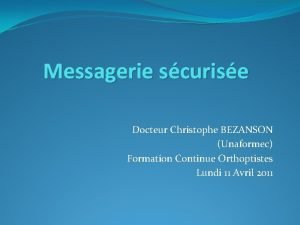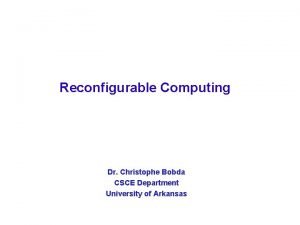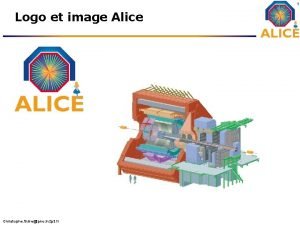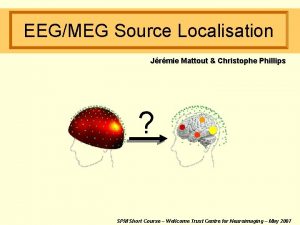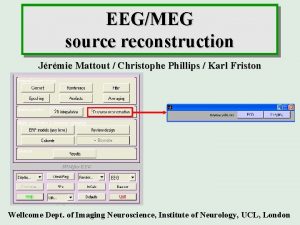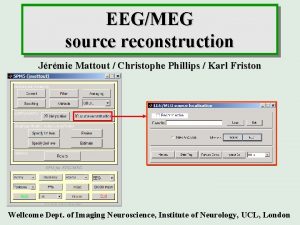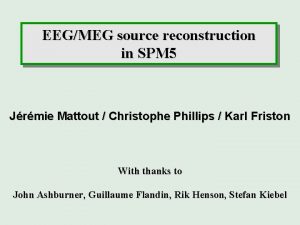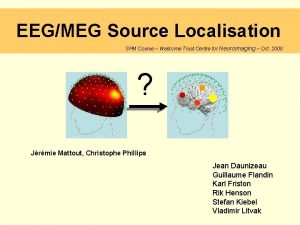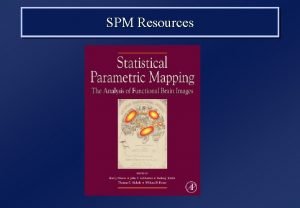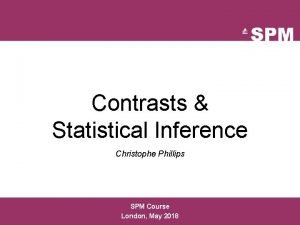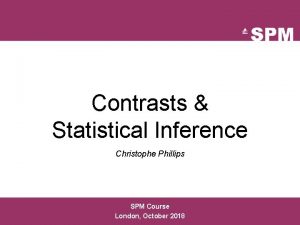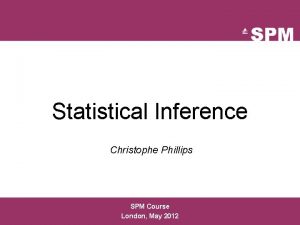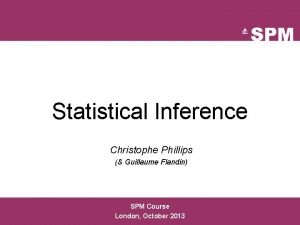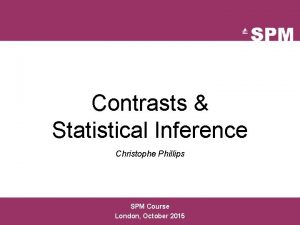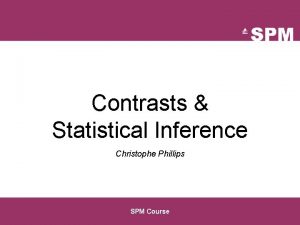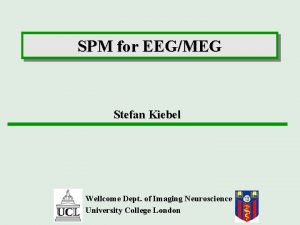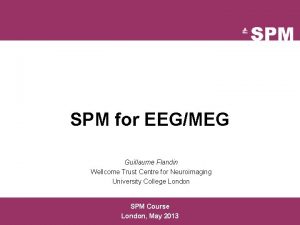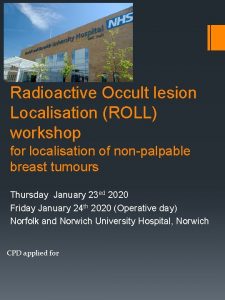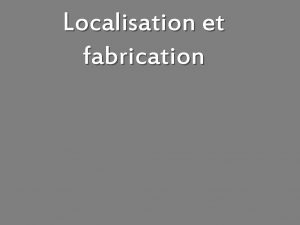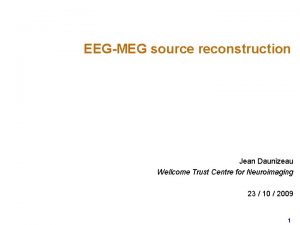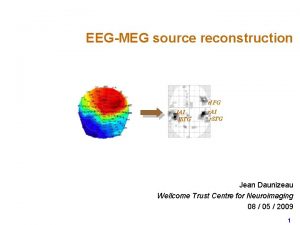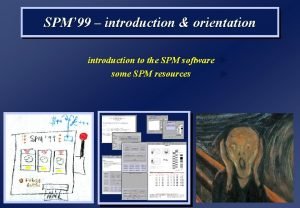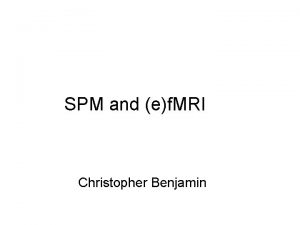EEGMEG Source Localisation Jrmie Mattout Christophe Phillips SPM
































- Slides: 32

EEG/MEG Source Localisation Jérémie Mattout & Christophe Phillips ? SPM Short Course – Wellcome Trust Centre for Neuroimaging – May 2007

EEG/MEG Source localisation Introduction Data Preprocessing Source reconstruction Scalp Data Analysis Statistical Parametric Mapping Dynamic Causal Modelling

EEG/MEG Source localisation Overview Forward Computation (K) Inverse Computation EEG/MEG sources EEG/MEG generative model Equivalent Current Dipoles (ECD) Imaging or Distributed EEG/MEG inverse methods

EEG/MEG Source localisation Equivalent Current Dipoles (ECD) An ill-posed inverse problem Imaging or Distributed Jacques Hadamard (1865 -1963) 1. Existence 2. Unicity 3. Stability EEG/MEG inverse methods « Will it ever happen that mathematicians will know enough about the physiology of the brain, and neurophysiologists enough of mathematical discovery, for efficient cooperation to be possible ? »

EEG/MEG Source localisation Equivalent Current Dipoles (ECD) An ill-posed inverse problem Imaging or Distributed Jacques Hadamard (1865 -1963) 1. Existence 2. Unicity 3. Stability EEG/MEG inverse methods Prior information is needed

EEG/MEG Source localisation Bayesian Formulation « Will it ever happen that mathematicians will know enough about the physiology of the brain, and neurophysiologists enough of mathematical discovery, for efficient cooperation to be possible ? » Jacques Hadamard Bayes’ Rule ? Posterior Y: data J : sources M: model assumptions Likelihood Priors Gaussian densities: defined by their means and variances

EEG/MEG Source localisation General procedure Inversion

EEG/MEG Source localisation User interface File manager Current Analysis Meshing Co-registration Forward computation Inverse solution

EEG/MEG Source localisation Anatomical model – Source space Individual cortical mesh MNI Space Canonical mesh Subject’s MRI Anatomical warping [Un]-normalising spatial transformation Cortical mesh

EEG/MEG Source localisation Coregistration From Sensor to MRI space EEG fiducials Head. Shape Rigid + Transformation Surface Matching Head. Shape MRI derived meshes MEG Full setup

EEG/MEG Source localisation Forward Computation Computing the operator K 3 spheres EEG/MEG sources 1 sphere # sensors # dipoles K Lead field matrix

EEG/MEG Source localisation Data Likelihood Linear Generative Model Mesh shape and size Head model M

EEG/MEG Source localisation Priors on the sources Incorporating Multiple Priors # dipoles … IID (Minimum Norm) Spatial smoothness (LORETA) Multiple sparse priors (MSP)

EEG/MEG Source localisation Parametric Empirical Bayesian Inference (I) Hierarchical model … Model Mi 2 nd Level … 1 st Level Mesh shape and size Likelihood Posterior Evidence Prior Head model

EEG/MEG Source localisation Parametric Empirical Bayesian Inference (II) EM/Re. ML algorithm M-step E-step ^ C, ^ λ^ and μ^ - PEB inference yields posterior estimates: J, ^ ^ - Knowing J and C, Posterior Probability Maps (PPM) can be computed

EEG/MEG Source localisation Parametric Empirical Bayesian Inference (III) Model comparison p(Y|Mi) 1 2 3 model Mi

EEG/MEG Source localisation Conclusion First level analysis PEB PPM Second level analysis Individual summary statistics … RFX analysis p < 0. 01 uncorrected SPM

To be continued…

EEG/MEG Source localisation ECD approach Forward Computation (K) Inverse Computation EEG/MEG sources EEG/MEG generative model Equivalent Current Dipoles (ECD) Imaging or Distributed EEG/MEG inverse methods

EEG/MEG Source localisation ECD approach: model Problem to solve: Y = KJ + E A priori fixed number of sources considered, (usually less than 5) over-determined but nonlinear problem iterative fitting of the 6 parameters of each source K depends on the source location r → non-linear relationship with Y : Y = K(r) J + E J are the source intensity (incl. orientation) ^ = K J^ → linear relationship with Y, once K is fixed: J^ = K - Y and Y

Source localisation ECD approach: optimisation 1 D example of optimisation problem: Cost function EEG/MEG Value of parameter Local minimum Global minimum The iterative optimisation procedure can only find a local minimum the starting location(s) used can influence the solution found !

EEG/MEG Source localisation ECD approach: results For an ECD solution, initialise the dipoles • at multiple random locations and repeat the fitting procedure cluster of solutions ? • at a «guessed» solution spot, • then let the dipole free to move • keep the location fixed (also named « seeded-ECD » ) Eventually, • Simple focused solution: dipole coordinates • Time course of activity for each dipole

EEG/MEG Source localisation ECD approach: interpretation and limitation • How many dipoles ? The more sources, the better the fit… in a mathematical sense !!! (Still the number of sources limited : 6 x. Ns < Ne) • Moreover it is NOT possible to mathematically compare 2 models with different number of sources ! • Is a dipole, i. e. a punctual source, the right model for a patch of activated cortex ? • What about the influence of the noise ? Find the confidence interval. • Is the seeded-ECD a good approach ? Given that you find what you put in…

EEG/MEG Source localisation ECD approach: application epilepsy 2 D EEG map of first peak, above F 4 front L R back


EEG/MEG Source localisation Forward Problem: analytical vs. numerical solution The head is NOT spherical: cannot use the exact analytical solution because of model/anatomical errors. Realistic model needs BEM solution: surfaces extraction computationnaly heavy errors for superficial sources Could we combine the advantages of both solutions ? Anatomically constrained spherical head models, or pseudo-spherical model.

EEG/MEG Source localisation Anatomically constrained spherical model Scalp (or brain) surface Best fitting sphere: centre and radii (scalp, skull, brain) Spherical transformation of source locations Leadfield for the spherical model

EEG/MEG Source localisation Anatomically constrained spherical model Dipole: defined by its polar coordinates (Rd, IRM, qd, fd ) Fitted sphere: defined by its centre and radius, (c. Sph, RSph) Fitted sphere Direction (qd, fd) Rscalp(qd, fd) Rd, IRM c. Sph RSph Scalp surface

EEG/MEG Source localisation Application: scalp surface Fitted sphere and scalp surface

EEG/MEG Source localisation Application: cortical surface

EEG/MEG Source localisation

EEG/MEG Source localisation Priors on the sources (II) Hyperpriors - Log-normal hyperpriors - Enforces the non-negativity of the scale parameters - Enables Automatic Relevance Determination (ARD)
 Christophe phillips
Christophe phillips Christophe phillips
Christophe phillips Localisation absolue et relative
Localisation absolue et relative Tissu nodal localisation
Tissu nodal localisation Localisation gps
Localisation gps Localisation
Localisation Tissu nodal
Tissu nodal Cms localisation
Cms localisation Polygone de willis localisation
Polygone de willis localisation Localization industry standards association
Localization industry standards association Osmorécepteurs localisation
Osmorécepteurs localisation Localisation of distributed data
Localisation of distributed data Localisation
Localisation Eemien
Eemien Localisation
Localisation Localisation sensor data
Localisation sensor data Ecg localisation of mi
Ecg localisation of mi Localisation danemark
Localisation danemark Pachyte
Pachyte Christophe douaud
Christophe douaud Christophe venet
Christophe venet Christophe rousseau
Christophe rousseau Unaformec
Unaformec Christophe frippiat
Christophe frippiat Christophe boeraeve
Christophe boeraeve Christophe burucoa
Christophe burucoa Christophe collette
Christophe collette Astro queyras
Astro queyras Christophe bobda
Christophe bobda Alice christophe
Alice christophe Ski classe 2
Ski classe 2 Christophe collette
Christophe collette Open 4es shaders
Open 4es shaders
